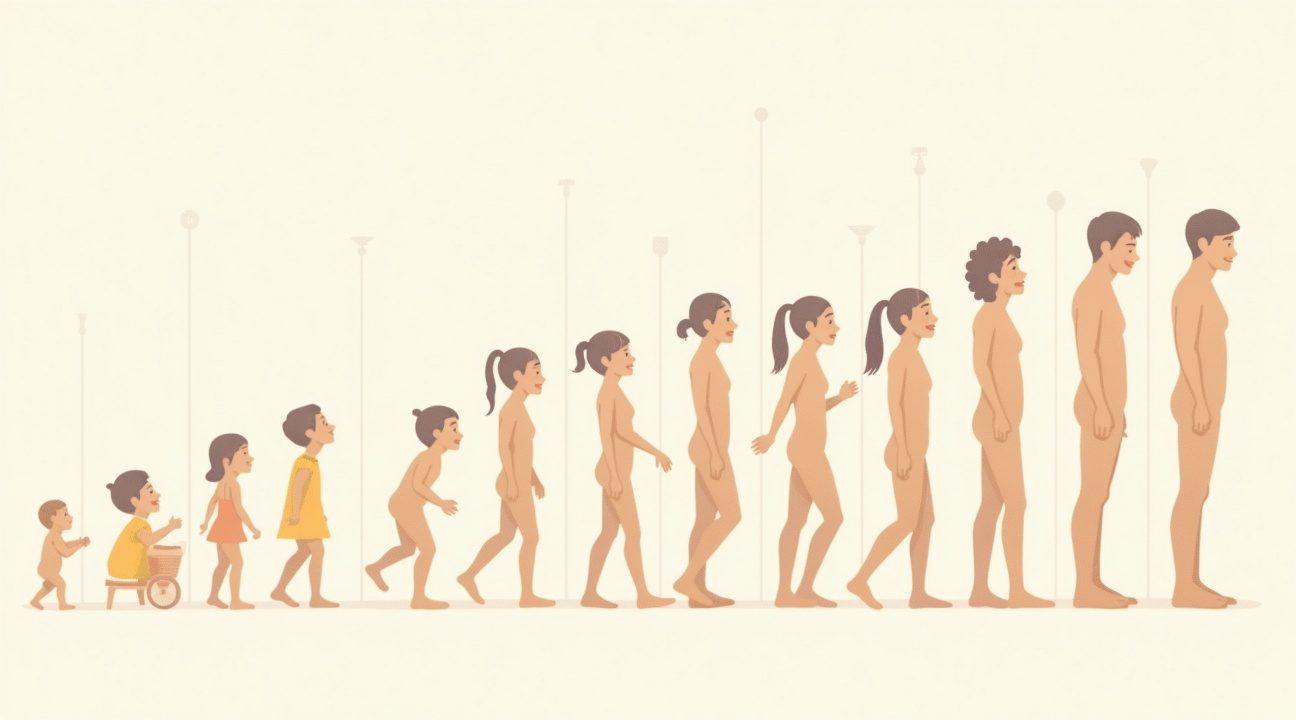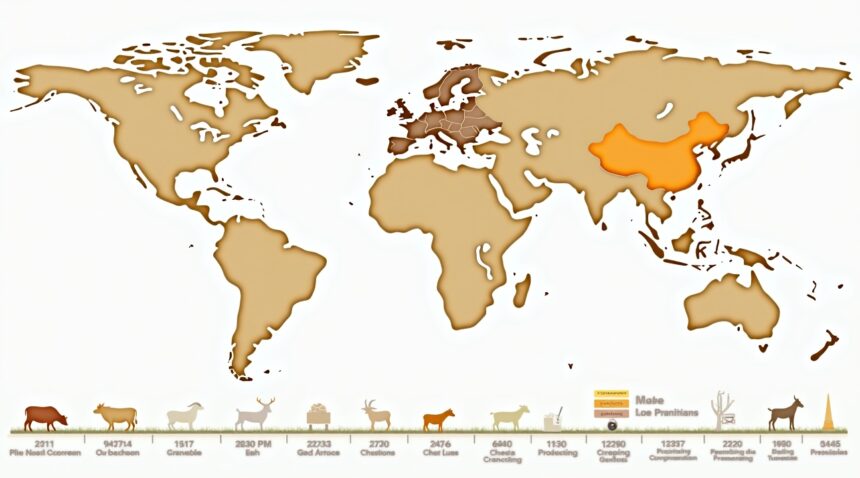Most adults worldwide are lactose intolerant, making the ability to digest milk as an adult a genetic mutation rather than the biological norm.
Key Takeaways
- Approximately 65-70% of adults globally are lactose intolerant, making adult milk digestion a genetic minority trait rather than the human standard.
- Lactase persistence evolved independently in different populations with dairy farming traditions, including Northern Europeans, East Africans, and some Middle Eastern groups.
- Most humans naturally lose lactase production after weaning, with the timeline varying by ethnicity—Asian populations decline within 3-4 years while Northern Europeans may maintain production until age 18-20.
- The mutation spread rapidly through dairy-farming societies because it provided crucial survival advantages during harsh seasons and droughts.
- Lactose intolerance symptoms include gas, bloating, diarrhea, and abdominal cramping, but tolerance levels vary significantly between individuals, with many able to handle small amounts of dairy when consumed with meals.
Understanding Lactase Persistence
The standard human condition involves losing the ability to digest lactose after childhood. Scientists consider lactase persistence an evolutionary anomaly that emerged in response to specific environmental pressures. Natural selection favored individuals who could continue digesting milk into adulthood, particularly in regions where dairy animals became essential for survival.
Geographic Distribution
Geographic distribution of lactase persistence correlates strongly with historical dairy farming practices. Northern European populations show the highest rates of milk tolerance, with over 90% maintaining lactase production throughout life. East African groups, particularly the Maasai and other pastoralist communities, developed similar adaptations independently. These populations relied heavily on cattle for sustenance, making milk digestion a crucial survival advantage.
Genetic Origins and Evolution
The genetic mutations responsible for lactase persistence occurred relatively recently in human history. Archaeological evidence suggests these changes emerged within the last 10,000 years, coinciding with the development of agriculture and animal domestication. This timeline makes lactase persistence one of the fastest-spreading genetic adaptations in human evolution.
Different populations carry distinct genetic variants that enable lactase persistence. Europeans primarily carry the -13910*T allele, while East Africans possess different mutations that achieve the same result. This example of convergent evolution demonstrates how similar environmental pressures led to comparable genetic solutions across separate populations.
Lactose Intolerance in Populations
Ethnic Variation
Lactose intolerance manifests differently across ethnic groups. Asian populations typically lose lactase production earliest, often by age 3–4. African populations generally maintain some enzyme production slightly longer but still experience significant decline by early childhood. European-descended individuals may retain partial lactase activity until their late teens or early twenties before experiencing gradual reduction.
Variability in Symptoms
The severity of lactose intolerance symptoms varies considerably among affected individuals. Some people experience severe digestive distress from even small amounts of dairy, while others can consume moderate quantities without significant discomfort. Factors influencing tolerance include the specific genetic variant present, individual gut microbiome composition, and the type of dairy product consumed.
Coping Strategies and Dietary Adaptations
Fermented and Aged Dairy
Fermented dairy products often cause fewer symptoms than fresh milk. Yogurt and aged cheeses contain lower lactose levels due to bacterial fermentation processes that break down much of the milk sugar. Many lactose-intolerant individuals can enjoy these products without experiencing digestive issues.
Timing of Consumption
Timing of dairy consumption also affects symptom severity. Consuming milk or dairy products alongside other foods slows gastric emptying and reduces the concentration of lactose reaching the small intestine. This dilution effect often allows better tolerance compared to consuming dairy on an empty stomach.
Modern Solutions
Modern understanding of lactose intolerance has led to numerous dietary adaptations and commercial solutions. Lactase enzyme supplements allow many people to enjoy dairy products without symptoms. Food manufacturers now produce lactose-free versions of milk, cheese, and other dairy items that maintain nutritional value while eliminating problematic sugars.
Evolutionary and Nutritional Implications
The rise of dairy farming fundamentally changed human nutrition and survival strategies. Populations with lactase persistence gained access to a reliable protein and calorie source that could sustain them through seasonal food shortages. Milk provided essential nutrients during times when crops failed or hunting proved unsuccessful.
The prevalence of lactose intolerance challenges common assumptions about human dietary requirements. Many nutritional guidelines assume universal milk tolerance, despite the fact that most adults cannot properly digest dairy products. This disconnect highlights the importance of understanding genetic diversity in human nutrition.
Cultural Reflections of Genetic Traits
Cultural practices around dairy consumption reflect underlying genetic realities. Societies with high rates of lactose intolerance traditionally developed cuisines that minimize dairy use or incorporate fermented dairy products. Asian cuisines typically feature little fresh milk, while European traditions heavily emphasize dairy consumption.
Recognition of lactose intolerance as the human norm rather than an abnormality represents a significant shift in nutritional thinking. This perspective emphasizes the importance of considering genetic variation when making dietary recommendations and developing food policies.
Conclusion
The study of lactase persistence continues to offer valuable insights into human evolution and adaptation. Scientists use this genetic trait to understand how environmental pressures can shape our biology and drive rapid evolutionary changes. This knowledge supports broader efforts to appreciate human genetic diversity and tailor nutrition to meet varied biological needs across global populations.
The Evolutionary Plot Twist: Why Adults Who Drink Milk Have a Genetic Mutation
I find it fascinating that drinking milk as an adult actually marks you as having a genetic mutation rather than being “normal.” Most humans lose their ability to produce lactase—the enzyme that breaks down milk sugar—after weaning, making lactose intolerance the default state for our species.
This genetic change, called lactase persistence, represents one of evolution’s most recent success stories. Adults with this mutation continue producing lactase throughout their lives, allowing them to digest dairy without experiencing the uncomfortable bloating, gas, or diarrhea that affects most of the global population.
How Natural Selection Favored Milk Drinkers
The mutation spread rapidly through certain populations because it provided significant survival advantages. Communities that domesticated cattle, goats, and sheep gained access to a reliable protein and calorie source that could sustain them through harsh seasons or droughts. Unlike many scientific theories about ancient human behavior, this evolutionary adaptation happened recently enough that researchers can trace its development with remarkable precision.
Natural selection strongly favored individuals who could digest milk in dairy-farming societies. These populations experienced what scientists call positive selection, where beneficial traits spread quickly through genetic lineages. The mutation near the LCT gene essentially keeps the lactase production switch turned “on” instead of shutting down after childhood.
Different populations developed slightly different versions of this same adaptation. Europeans, East Africans, and some Middle Eastern groups each evolved their own genetic variants that achieve the same result. I think this parallel evolution demonstrates just how valuable dairy consumption became for human survival.
The geographic distribution of lactase persistence tells a clear story about human migration and agricultural development:
- Northern Europeans show the highest rates of the mutation, with over 90% of adults able to digest milk.
- These high rates correlate with regions where dairy farming became a cornerstone of food security.
- Populations without historical dairy traditions, such as many Asian and African groups, maintain low lactase persistence levels.
What surprises many people is that roughly 65% of adults worldwide remain lactose intolerant, making milk-drinking adults the genetic minority. Energy drink consumption in these regions often provides different nutritional solutions than traditional dairy products.
The speed at which this mutation spread through human populations demonstrates evolution in action. Within just a few thousand years, lactase persistence went from virtually nonexistent to dominant in certain regions. This rapid genetic shift shows how powerful environmental pressures can reshape human biology when survival advantages are significant enough.
Most of the World Can’t Handle Dairy: The Shocking Global Statistics
I find it fascinating that lactose intolerance affects approximately 65-70% of the global adult population, making those who can digest milk as adults the minority rather than the norm. This widespread inability to process dairy after childhood represents the natural state for most humans, highlighting just how unusual the ability to drink milk into adulthood really is.
Geographic and Ethnic Patterns Reveal Dramatic Differences
The distribution of lactose intolerance varies dramatically across different regions and ethnic groups. East Asia, Africa, and South America show the highest prevalence rates, with certain populations experiencing intolerance levels reaching 80-100%. These statistics demonstrate that lactase nonpersistence is the standard biological condition for most humans outside specific populations.
American ethnic groups display particularly striking patterns in their ability to digest dairy:
- American Indians face nearly 100% lactose intolerance rates
- Asian Americans experience approximately 90% intolerance
- African Americans and Native Americans show around 80% prevalence
- Hispanic and Latino populations also demonstrate high rates of lactose intolerance
People of Northern European descent stand out as a clear exception to this global pattern. These populations, along with others with historical dairy consumption traditions, exhibit the lowest lactose intolerance rates, ranging from just 2% to 26%. This dramatic difference isn’t coincidental – it reflects thousands of years of evolutionary adaptation to dairy farming cultures.
I’ve observed that these statistics often surprise people from dairy-consuming cultures, who may assume their ability to digest milk represents the human norm. However, the data reveals that adult milk digestion is actually an evolutionary anomaly that developed in specific populations through genetic mutation and natural selection.
The prevalence patterns also correlate strongly with historical dairy farming practices. Populations that traditionally relied on cattle, goats, or sheep for milk developed genetic adaptations that allowed continued lactase production into adulthood. Meanwhile, societies that didn’t practice dairy farming maintained the ancestral pattern of losing lactase production after weaning.
Understanding these global statistics helps explain why dairy products remain absent from traditional cuisines in many parts of Asia, Africa, and the Americas. What might seem like a strange biological quirk actually represents a practical adaptation to local food systems and genetic heritage.
These numbers also have significant implications for global nutrition recommendations and food policy. Recognizing that most adults worldwide cannot properly digest dairy challenges assumptions about universal dietary guidelines and highlights the importance of culturally appropriate nutrition advice.
Your Body’s Natural Timeline: How We Lose the Ability to Process Milk
I’ve discovered that most people enter this world equipped with a remarkable ability to digest milk, thanks to their body’s natural production of lactase enzyme. This biological gift serves a crucial purpose during infancy when breast milk provides essential nutrition. However, nature didn’t intend for this capability to last forever.
After the weaning phase, lactase production begins its inevitable decline in most individuals. This process, called primary lactase deficiency, represents the body’s original genetic programming rather than a medical condition. The timing and severity of this decline varies dramatically based on ethnic background and individual genetics.
How Different Populations Experience Lactase Decline
The rate at which people lose their ability to process milk differs significantly across ethnic groups.
- Chinese and Japanese individuals experience the most rapid decline, typically losing 80-90% of their lactase activity within just 3-4 years after weaning. This swift transition explains why dairy products remain relatively uncommon in traditional Asian cuisines.
- Jewish and other Asian populations follow a somewhat gentler timeline, experiencing a 60-70% decline in lactase production that occurs more gradually over several years.
- Northern Europeans and North Americans often maintain significant lactase levels much longer, often retaining substantial enzyme production until 18-20 years of age before experiencing their decline.
These variations highlight how different populations adapted to their local food sources throughout history. Groups that historically relied on dairy farming developed genetic traits that allowed them to continue digesting milk into adulthood, while populations without access to domesticated dairy animals maintained the standard mammalian pattern of losing lactase production after weaning.
Secondary lactase deficiency presents a different scenario entirely. Unlike the genetically programmed primary deficiency, this condition results from intestinal injury, infection, or diseases such as celiac or Crohn’s disease. These medical conditions can damage the intestinal lining where lactase enzymes are produced, leading to temporary or permanent lactose intolerance regardless of genetic background.
I find it fascinating that what many consider “normal” – the ability to drink milk as adults – actually represents a relatively recent evolutionary adaptation. The standard mammalian blueprint calls for declining lactase production after weaning, making adult lactose intolerance the biological norm rather than the exception.
Understanding your body’s natural timeline helps explain why some people can enjoy energy drinks and dairy-based smoothies without issue while others experience digestive discomfort. The timing of lactase decline also explains why some individuals don’t discover their lactose intolerance until their teens or early twenties.
Environmental factors can influence this timeline as well:
- Continued consumption of dairy products may help maintain lactase production longer in some individuals
- Complete avoidance of lactose can accelerate the decline
- Illness, stress, and certain medications can also affect enzyme production temporarily
The gradual nature of lactase decline means many people don’t immediately recognize the connection between dairy consumption and digestive symptoms. Someone might notice mild discomfort after drinking milk but not realize it’s related to decreasing enzyme production. This delayed recognition often leads to years of unexplained digestive issues before people identify the culprit.
Recognizing these natural patterns empowers individuals to make informed dietary choices. Rather than viewing lactose intolerance as a limitation, understanding it as the body’s default setting helps normalize the experience for the majority of adults worldwide who share this trait.
The science behind lactase production decline reveals just how remarkable it is that some adults can continue enjoying dairy products throughout their lives. Their genetic mutation represents a relatively recent evolutionary development that allowed certain populations to thrive in environments where dairy farming became central to survival.
https://www.youtube.com/watch?v=3VvyELbWqMo

The Dairy Dilemma: What Happens When Your Body Rebels Against Milk
When someone lacks sufficient lactase enzyme, their body launches an uncomfortable rebellion against dairy products. I’ve seen countless individuals struggle with the classic quartet of symptoms that defines lactose intolerance: gas, bloating, diarrhea, and abdominal cramping. These reactions occur because undigested lactose ferments in the colon, creating a cascade of digestive distress.
Understanding Symptom Severity and Individual Variations
The intensity of these symptoms varies dramatically from person to person. Some individuals experience severe reactions from just a small amount of dairy, while others can manage modest portions without significant discomfort. Research shows that many people can tolerate approximately one cup of milk, which contains roughly 12 grams of lactose, particularly when consumed alongside a meal. This tolerance level changes based on factors like genetic background, gut bacteria composition, and individual enzyme production levels.
Interestingly, timing and food combinations play crucial roles in symptom management. Consuming dairy with other foods slows gastric emptying, giving whatever lactase enzyme remains more time to work. This explains why some people can enjoy certain beverages containing dairy without issues when paired with meals.
The Broader Impact on Daily Life
Beyond immediate physical discomfort, lactose intolerance significantly impacts quality of life and nutritional choices. Many affected individuals must carefully scrutinize food labels, avoid social dining situations, or carry lactase supplements everywhere they go. The condition influences everything from coffee shop visits to family gatherings where dairy-heavy dishes dominate the menu.
The psychological aspect shouldn’t be overlooked either. Constant vigilance about food choices creates stress and can lead to nutritional deficiencies if calcium and vitamin D sources aren’t properly replaced. I often observe people developing anxiety around eating situations, particularly in social settings where dietary restrictions might draw unwanted attention.
The dairy industry has responded to this widespread condition by developing lactose-free alternatives, but these products often come with higher price tags and different taste profiles. This economic burden adds another layer to the challenge, especially for families where multiple members share the same genetic limitation. Despite these obstacles, understanding one’s lactose tolerance level allows for better management strategies and improved overall digestive health.
Sources:
NCBI Bookshelf: “Lactose Intolerance – StatPearls”
Canadian Digestive Health Foundation: “Lactose Intolerance”
Intermountain Healthcare: “Lactose Intolerance: Millions of Americans Don’t Know They Have It”
MedlinePlus Genetics: “Lactose intolerance”
Boston Children’s Hospital: “Lactose Intolerance”
NIDDK: “Definition & Facts for Lactose Intolerance”
World Population Review: “Lactose Intolerance by Country 2025”


